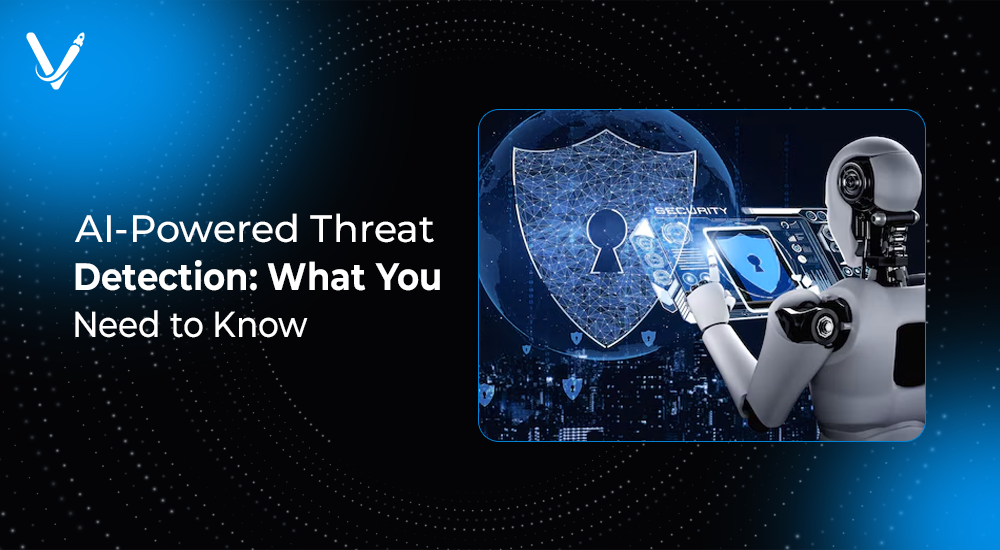AI-Powered Threat Detection: What You Need to Know


- Aug 19, 2025
Cybersecurity is no longer just a concern for IT teams—it has become a mission-critical function for every business, regardless of size or industry. As cyberattacks grow more complex, traditional defenses like firewalls, signature-based antivirus software, and manual monitoring are no longer enough. Attackers are using automation, machine learning, and even generative AI to scale their attacks, leaving conventional tools struggling to keep up.
This is where AI-powered threat detection enters the picture. By leveraging artificial intelligence and machine learning, organizations can identify threats faster, adapt to new attack methods, and stop malicious activity before it escalates into a full-blown security breach. Unlike traditional security systems, AI-based platforms don’t rely solely on predefined rules. Instead, they continuously learn from data, adapt to emerging patterns, and offer real-time visibility across the entire IT ecosystem.
In this article, we’ll explore what AI-powered threat detection is, how it works, its real-world applications, and the opportunities and challenges it brings. We’ll also look at future trends shaping the field and share practical insights for businesses aiming to strengthen their security posture in 2025 and beyond.
AI-powered threat detection is the use of artificial intelligence, machine learning, and deep learning to identify malicious activity within networks, systems, and applications. Unlike traditional methods that rely on static rules or known malware signatures, AI continuously analyzes massive volumes of data—network traffic, logs, user behavior, and device activity—to spot suspicious patterns that may indicate a cyberattack.
For example, if an employee’s account suddenly attempts to download gigabytes of sensitive data outside normal business hours, an AI-driven system could detect this anomaly and flag it as a potential insider threat or compromised account.
Traditional security solutions were designed for an era when threats were simpler, slower, and more predictable. Today’s attackers use sophisticated techniques such as zero-day exploits, polymorphic malware, and AI-driven phishing campaigns. Static defenses can’t keep up because:
AI-powered systems address these challenges by learning and adapting in real time, improving detection accuracy, and reducing response time.
Speed is everything in cybersecurity. Traditional tools may take hours or even days to identify and investigate an attack. AI can detect suspicious activity within seconds, stopping ransomware before it encrypts data or blocking phishing attempts before employees click malicious links.
AI models improve over time by training on new data, including both successful detections and false positives. This continuous improvement ensures that AI systems stay ahead of evolving threats.
AI processes massive volumes of data at machine speed, allowing organizations to spot and stop attacks before they escalate.
By reducing false positives, AI allows security teams to focus on genuine threats instead of wasting time chasing down harmless alerts.
Instead of waiting for an attack to happen, AI uses predictive analytics to anticipate risks and prevent them in advance.
AI-based systems can handle data from thousands of endpoints, cloud applications, and IoT devices—something human analysts simply cannot achieve at scale.
Although implementing AI-based solutions requires investment, the long-term savings are significant. Preventing a data breach saves millions in potential losses, legal fees, and reputational damage.
AI can detect ransomware activity early by identifying unusual file encryption patterns and automatically halting the process before critical data is locked.
NLP-powered AI scans emails, URLs, and attachments to detect phishing attempts that look legitimate to human eyes.
AI tracks user behavior across systems to detect anomalies that may indicate malicious insiders or compromised accounts.
With the rise of SaaS and cloud-native applications, AI ensures security by continuously monitoring workloads, API traffic, and access patterns.
IoT devices are often poorly secured, making them easy targets. AI identifies compromised devices and prevents them from being used in botnet attacks.
Financial institutions use AI to detect anomalies in transactions—such as unusual spending patterns or login activity—reducing fraud losses.
Cyber threats are evolving at lightning speed, but so is technology. AI-powered threat detection is transforming cybersecurity by enabling real-time analysis, predictive defense, and automated response. While challenges like cost, data privacy, and adversarial attacks exist, the benefits far outweigh the drawbacks. Businesses that adopt AI-driven security solutions can reduce risk, protect sensitive data, and ensure business continuity in a digital-first world.
At Vasundhara Infotech, we help businesses integrate AI-powered solutions that not only safeguard operations but also accelerate growth. If you’re looking to strengthen your cybersecurity strategy and embrace the future of digital defense, our team is ready to guide you. Get in touch with us.
What is AI-powered threat detection?
It’s the use of artificial intelligence and machine learning to identify and stop cyberattacks in real time.
How does AI improve over traditional security methods?
AI continuously learns, adapts to new threats, reduces false positives, and enables faster responses.
Can small businesses afford AI-powered security?
Yes, cloud-based AI security tools make enterprise-grade protection accessible to SMBs.
Is AI enough to stop all cyberattacks?
No system is foolproof. AI should be combined with skilled human analysts and layered security measures.
What’s the future of AI in cybersecurity?
The future lies in predictive, autonomous, and collaborative AI systems that defend businesses against emerging global threats.
Copyright © 2025 Vasundhara Infotech. All Rights Reserved.
